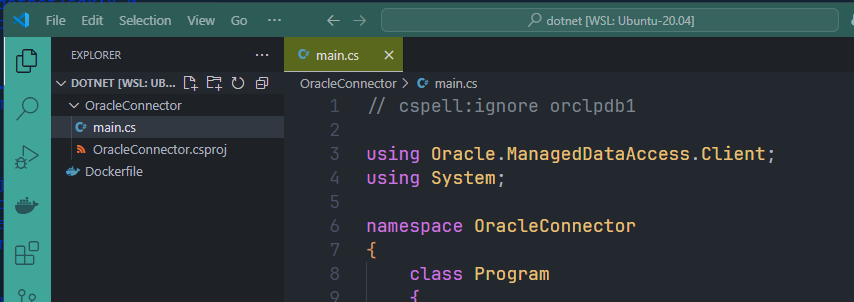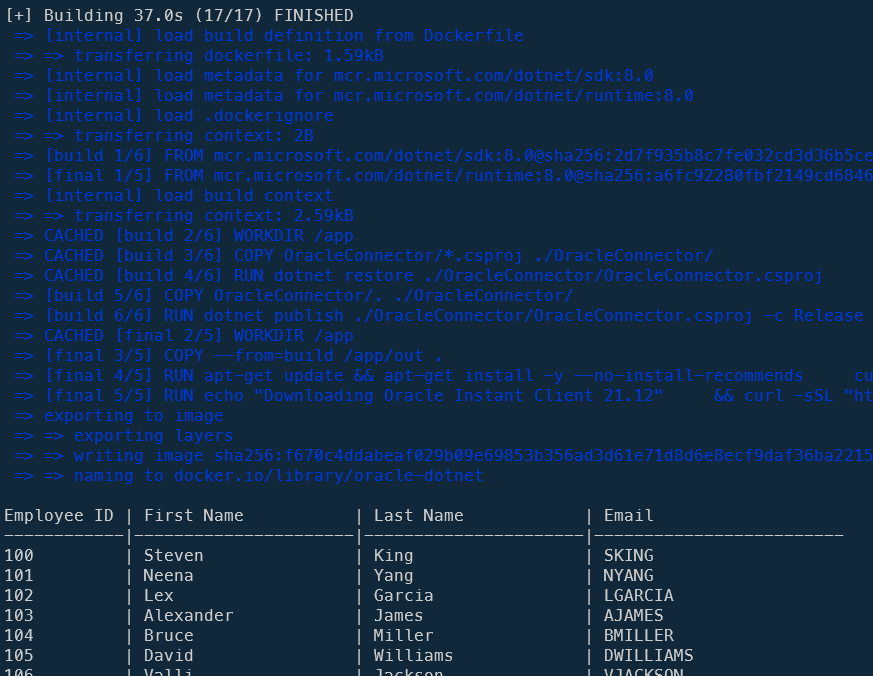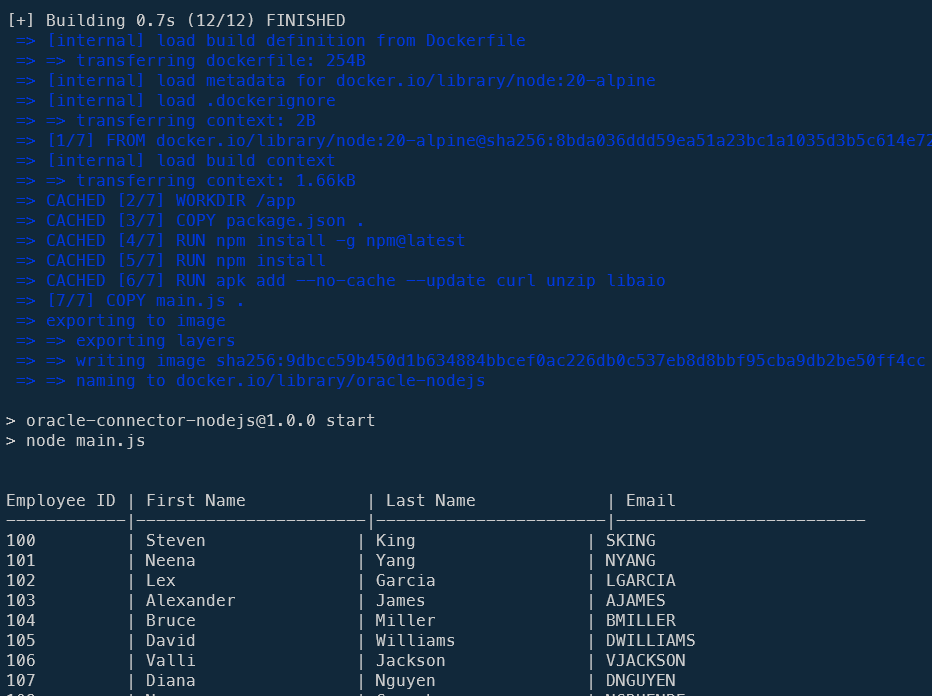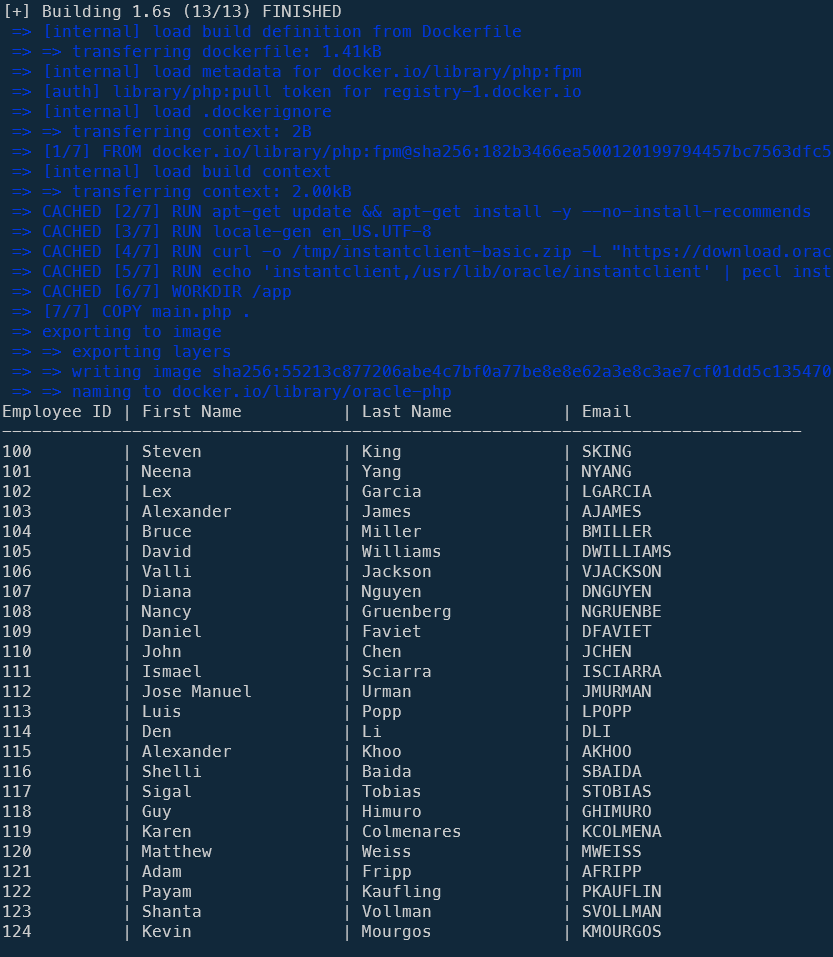Accessing an Oracle database using .Net, NodeJS, PHP and Python

In a previous article (Running Oracle Database Server as a Docker container), we've created a Docker container called oracle-db where a Human Resources database is running.
This time, let's play with .Net, NodeJS, PHP and Python to access to it and display records.
For each language, we'll build a Docker image with all the required stuff like Oracle Instant Client then we'll create a small script to connect to the employees table and display records.
The idea is then to provide a very quick skeleton for starting a project in those languages and if you need to directly connect to an Oracle database.
In the Running Oracle Database Server as a Docker container article, we've created a Docker container called oracle-db where a Human Resources database is running.
Please read that article and follow steps so, before continuing here, you've a running Docker container like describe below.
Some prerequisites
- You've a running Docker container called
oracle-db, - The container is thus running on your
localhost, - The port number to access your database is
1521, - The credentials to use is
SYS(orSYSTEM) andadminfor the password, - The container contains a database called
ORCLPDB1(also called service name) which is the Human Resources sample of Oracle (refer to the mentioned article) and - Our database
oracle-dbis running on a network calledoracle.
The code samples were largely created using AI
Because it's fast to do and also because I don't know .Net and very few NodeJs, I've used Google Gemini for building my samples below. Sometimes like for .Net, it was almost ready-to-use. Sometimes for PHP, it was more difficult and it took a lot on fiddling on my part to find the right configuration.
Nevertheless the objective of this article was to provide the minimum set of files in order to connect to an Oracle DB, run a SELECT query and display results; not to have best-in-class codebase.
Access our Oracle DB container using .Net
First language by alphabetical order; let's play with a .Net container:
mkdir -p /tmp/oracle/dotnet && cd $_
Also create this directory:
mkdir -p /tmp/oracle/dotnet/OracleConnector
Let's create a Dockerfile:
Dockerfile
# cspell:ignore libaio1,instantclient,libclntsh,libocci,ldconfig
FROM mcr.microsoft.com/dotnet/sdk:8.0 AS build
WORKDIR /app
COPY OracleConnector/*.csproj ./OracleConnector/
RUN dotnet restore ./OracleConnector/OracleConnector.csproj
COPY OracleConnector/. ./OracleConnector/
RUN dotnet publish ./OracleConnector/OracleConnector.csproj -c Release -o out
FROM mcr.microsoft.com/dotnet/runtime:8.0 AS final
WORKDIR /app
COPY --from=build /app/out .
# Install necessary Oracle Instant Client libraries
ARG ORACLE_INSTANT_CLIENT_VERSION=21.12
ARG ORACLE_DOWNLOAD_URL=https://download.oracle.com/otn_software/linux/instantclient/instantclient-basic-linuxx64.zip
RUN apt-get update && apt-get install -y --no-install-recommends \
curl \
unzip \
libaio1 \
&& rm -rf /var/lib/apt/lists/*
RUN curl -sSL "${ORACLE_DOWNLOAD_URL}" -o instantclient.zip \
&& mkdir -p /usr/lib/oracle/instantclient \
&& unzip -qq instantclient.zip -d /usr/lib/oracle/instantclient \
&& rm instantclient.zip \
&& ln -s /usr/lib/oracle/instantclient/libclntsh.so.${ORACLE_INSTANT_CLIENT_VERSION}.1 /usr/lib/oracle/instantclient/libclntsh.so \
&& ln -s /usr/lib/oracle/instantclient/libocci.so.${ORACLE_INSTANT_CLIENT_VERSION}.1 /usr/lib/oracle/instantclient/libocci.so \
&& echo "/usr/lib/oracle/instantclient" > /etc/ld.so.conf.d/oracle-instantclient.conf \
&& ldconfig
ENTRYPOINT ["dotnet", "OracleConnector.dll"]
Now, the DotNet part. We need two files: OracleConnector/OracleConnector.csproj and OracleConnector.csproj/main.cs.
OracleConnector/OracleConnector.csproj
<Project Sdk="Microsoft.NET.Sdk">
<PropertyGroup>
<OutputType>Exe</OutputType>
<TargetFramework>net8.0</TargetFramework>
<ImplicitUsings>enable</ImplicitUsings>
<Nullable>enable</Nullable>
</PropertyGroup>
<ItemGroup>
<PackageReference Include="Oracle.ManagedDataAccess.Core" Version="3.21.121" />
</ItemGroup>
</Project>
OracleConnector/main.cs
// cspell:ignore orclpdb1
using Oracle.ManagedDataAccess.Client;
using System;
namespace OracleConnector
{
class Program
{
static void Main(string[] args)
{
string dbHost = Environment.GetEnvironmentVariable("ORACLE_HOST") ?? "oracle-db";
string dbPort = Environment.GetEnvironmentVariable("ORACLE_PORT") ?? "1521";
string dbService = Environment.GetEnvironmentVariable("ORACLE_SERVICE") ?? "orclpdb1";
string dbUser = Environment.GetEnvironmentVariable("ORACLE_USER") ?? "system";
string dbPassword = Environment.GetEnvironmentVariable("ORACLE_PASSWORD") ?? "admin";
string connectionString = $"Data Source=(DESCRIPTION=(ADDRESS_LIST=(ADDRESS=(PROTOCOL=TCP)(HOST={dbHost})(PORT={dbPort})))(CONNECT_DATA=(SERVICE_NAME={dbService})));User ID={dbUser};Password={dbPassword};";
try
{
using (OracleConnection connection = new OracleConnection(connectionString))
{
connection.Open();
string sql = "SELECT employee_id, first_name, last_name, email FROM employees WHERE ROWNUM <= 25";
using (OracleCommand command = new OracleCommand(sql, connection))
using (OracleDataReader reader = command.ExecuteReader())
{
Console.WriteLine("\nEmployee ID | First Name | Last Name | Email");
Console.WriteLine("------------|----------------------|----------------------|-------------------------");
while (reader.Read())
{
int employeeId = reader.GetInt32(0);
string firstName = reader.GetString(1);
string lastName = reader.GetString(2);
string email = reader.GetString(3);
Console.WriteLine($"{employeeId,-12}| {firstName,-21}| {lastName,-21}| {email}");
}
}
}
}
catch (OracleException ex)
{
Console.WriteLine($"Error connecting to or querying Oracle: {ex.Message}");
}
catch (Exception ex)
{
Console.WriteLine($"An unexpected error occurred: {ex.Message}");
}
}
}
}
This is how your project looks like in VSCode:

Still in the console, located in folder /tmp/oracle/dotnet, create the Docker image and run the container (and thus the script): clear ; docker build -t oracle-dotnet . && docker run --rm -it --network oracle oracle-dotnet.

Job done, our .Net code has accessed to the list.
Access our Oracle DB container using NodeJS
Second in the alphabetical order, let's play with a NodeJS container:
mkdir -p /tmp/oracle/nodejs && cd $_
Let's create a Dockerfile:
Dockerfile
# cspell:ignore libaio
FROM node:20-alpine
WORKDIR /app
COPY package.json .
RUN npm install -g npm@latest
RUN npm install
RUN apk add --no-cache --update curl unzip libaio
COPY main.js .
CMD ["npm", "start"]
We also need these files:
package.json
{
"name": "oracle-connector-nodejs",
"version": "1.0.0",
"description": "Node.js script to connect to Oracle",
"main": "app.js",
"scripts": {
"start": "node main.js"
},
"dependencies": {
"oracledb": "^6.3.0"
}
}
main.js
// cspell:ignore orclpdb1, oracledb
const oracledb = require("oracledb");
async function run() {
let connection;
try {
const dbHost = process.env.ORACLE_HOST || "oracle-db";
const dbPort = process.env.ORACLE_PORT || "1521";
const dbService = process.env.ORACLE_SERVICE || "orclpdb1";
const dbUser = process.env.ORACLE_USER || "SYSTEM";
const dbPassword = process.env.ORACLE_PASSWORD || "admin";
const connectConfig = {
user: dbUser,
password: dbPassword,
connectString: `${dbHost}:${dbPort}/${dbService}`,
};
connection = await oracledb.getConnection(connectConfig);
const result = await connection.execute(
`SELECT employee_id, first_name, last_name, email FROM employees WHERE ROWNUM <= 25`, // Assuming your table is named 'EMPLOYEES'
);
console.log(
"\nEmployee ID | First Name | Last Name | Email",
);
console.log(
"------------|----------------------|-----------------------|-------------------------",
);
for (const row of result.rows) {
const employeeId = row[0];
const firstName = row[1];
const lastName = row[2];
const email = row[3];
console.log(
`${employeeId.toString().padEnd(12)}| ${firstName.padEnd(21)}| ${lastName.padEnd(21)}| ${email}`,
);
}
} catch (err) {
console.error("Error connecting to or querying Oracle:", err);
} finally {
if (connection) {
try {
await connection.close();
} catch (err) {
console.error("Error closing connection:", err);
}
}
}
}
run();
Still in the console, located in folder /tmp/oracle/nodejs, create the Docker image and run the container (and thus the script): clear ; docker build -t oracle-nodejs . && docker run --rm -it --network oracle oracle-nodejs.

Nice! As you can see, we can quite easily access to our Oracle database using NodeJS.
Access our Oracle DB container using PHP
And, last in the alphabetical order; let's finish with a PHP container:
mkdir -p /tmp/oracle/php && cd $_
And there, let's create a Dockerfile:
Dockerfile
# cspell:ignore instantclient,libaio1,libncurses5,libreadline8,ldconfig,pecl
FROM php:fpm
RUN apt-get update && apt-get install -y --no-install-recommends \
libaio1 \
libncurses5 \
libreadline8 \
locales \
unzip \
&& rm -rf /var/lib/apt/lists/*
RUN locale-gen en_US.UTF-8
ENV LANG=en_US.UTF-8
ENV LANGUAGE=en_US:en
ENV LC_ALL=en_US.UTF-8
ARG ORACLE_INSTANT_CLIENT_VERSION=21.12
# Downloading Oracle Instant Client
RUN curl -o /tmp/instantclient-basic.zip -L "https://download.oracle.com/otn_software/linux/instantclient/instantclient-basic-linuxx64.zip" \
&& curl -o /tmp/instantclient-sdk.zip -L "https://download.oracle.com/otn_software/linux/instantclient/instantclient-sdk-linuxx64.zip" \
&& mkdir -p /usr/lib/oracle \
&& unzip -o /tmp/instantclient-basic.zip -d /usr/lib/oracle \
&& unzip -o /tmp/instantclient-sdk.zip -d /usr/lib/oracle \
&& rm /tmp/*.zip \
&& ln -s /usr/lib/oracle/instantclient_* /usr/lib/oracle/instantclient \
&& sh -c "echo /usr/lib/oracle/instantclient > /etc/ld.so.conf.d/oracle-instantclient.conf" \
&& ldconfig
# Install OCI8 Extension
RUN echo 'instantclient,/usr/lib/oracle/instantclient' | pecl install oci8 \
&& docker-php-ext-enable oci8
WORKDIR /app
COPY main.php .
CMD [ "php", "main.php" ]
Then let's create a PHP script (generated using IA)
main.php
<?php
declare(strict_types=1);
// cspell:ignore orclpdb1,rownum,sqlt
$dbUser = "system";
$dbPassword = "admin";
$dbHost = "oracle-db";
$dbPort = "1521";
$dbServiceName = "orclpdb1";
$connection = null;
$statement = null;
try {
$dsn = "(DESCRIPTION=(ADDRESS_LIST=(ADDRESS=(PROTOCOL=TCP)(HOST={$dbHost})(PORT={$dbPort})))(CONNECT_DATA=(SERVICE_NAME={$dbServiceName})))";
/** @var resource|false $connection */
$connection = oci_connect($dbUser, $dbPassword, $dsn, "");
if (!$connection) {
$e = oci_error();
throw new Exception("Error connecting to Oracle: " . $e['message']);
}
$sql = "SELECT employee_id, first_name, last_name, email FROM system.employees WHERE ROWNUM <= :max_rows";
/** @var resource|false $statement */
$statement = oci_parse($connection, $sql);
if (!$statement) {
$e = oci_error($connection);
throw new Exception("Error parsing SQL statement: " . $e['message']);
}
$numRows = 25;
oci_bind_by_name($statement, ":max_rows", $numRows, SQLT_INT);
$result = oci_execute($statement);
if (!$result) {
$e = oci_error($statement);
throw new Exception("Error executing SQL statement: " . $e['message']);
}
echo "Employee ID | First Name | Last Name | Email\n";
echo str_repeat("-", 80) . "\n";
while (($row = oci_fetch_array($statement, OCI_ASSOC + OCI_RETURN_NULLS)) !== false) {
$employeeId = (int) $row['EMPLOYEE_ID'];
$firstName = $row['FIRST_NAME'];
$lastName = $row['LAST_NAME'];
$email = $row['EMAIL'];
printf("%-12d| %-20s| %-20s| %-26s\n", $employeeId, $firstName, $lastName, $email);
}
} catch (Exception $exception) {
echo "Error: " . $exception->getMessage() . "\n";
} finally {
if (is_resource($statement)) {
oci_free_statement($statement);
}
if (is_resource($connection)) {
oci_close($connection);
}
}
?>
Still in the console, located in folder /tmp/oracle/php, create the Docker image and run the container (and thus the script): clear ; docker build -t oracle-php . && docker run --rm -it --network oracle oracle-php.

Access our Oracle DB container using Python
Let's create a Python script now:
mkdir -p /tmp/oracle/python && cd $_
And his Dockerfile; the only thing we need (except Python) is to install the oracledb dependency. Quite straightforward.
Dockerfile
# cspell:ignore oracledb
FROM python:slim
WORKDIR /app
RUN pip install --no-cache-dir oracledb
COPY main.py main.py
CMD ["python", "main.py"]
Then let's create a Python script (generated using IA)
main.py
import oracledb
from typing import Optional, Tuple, List
# cspell:ignore oracledb,orclpdb1,sysdba,rownum
DB_USER: str = "SYS"
DB_PASSWORD: str = "admin"
DB_HOST: str = "oracle-db"
DB_PORT: int = 1521
DB_SERVICE_NAME: str = "orclpdb1"
connection: Optional[oracledb.Connection] = None
cursor: Optional[oracledb.Cursor] = None
try:
dsn: str = f"{DB_HOST}:{DB_PORT}/{DB_SERVICE_NAME}"
connection = oracledb.connect(
user=DB_USER,
password=DB_PASSWORD,
dsn=dsn,
mode=oracledb.AuthMode.SYSDBA,
)
cursor = connection.cursor()
sql: str = (
"SELECT employee_id, first_name, last_name, email "
"FROM system.employees "
"WHERE ROWNUM <= :max_rows"
)
num_rows: int = 25
cursor.execute(sql, max_rows=num_rows)
records: List[Tuple[int, str, str, str]] = cursor.fetchall()
print("Employee ID | First Name | Last Name | Email")
print("-" * 80)
employee_id: int
first_name: str
last_name: str
email: str
for record in records:
employee_id, first_name, last_name, email = record
print(f"{employee_id:<12}| {first_name:<20}| {last_name:<20}| {email:<26}")
except oracledb.Error as exception:
print(f"Error connecting to Oracle: {exception}")
finally:
if cursor:
try:
cursor.close()
except oracledb.Error as exception:
print(f"Error closing cursor: {exception}")
if connection:
try:
connection.close()
except oracledb.Error as exception:
print(f"Error closing connection: {exception}")
Still in the console, located in folder /tmp/oracle/python, create the Docker image and run the container (and thus the script): clear ; docker build -t oracle-python . && docker run --rm -it --network oracle oracle-python.

Nice! As you can see, we can quite easily access to our Oracle database using Python.
Conclusion
You know what? I've more than 15 years of experience with PHP and just 6 months using Python and, if we look at the Dockerfile of both languages, there is no doubt at all; the one for Python is so much easier to read and to configure. I had pain to make the one of PHP to works and just none for Python since it's just one dependency to install and that's all.
And if we look at PHP versus Python code, they are quite similar but, I should admit, the one for Python has my preference because we don't need to check for errors in multiple places, we can more easily define the data types of variables, the echo statement is more readable, ...